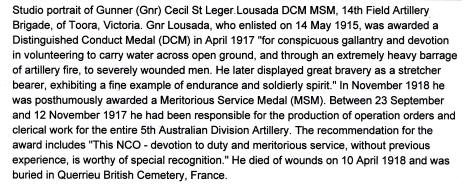
Cecil #85 died as a result of a shell explosion - two branches of the family believe his death was caused by a jammed shell in the gun he was operating. His brother Aubrey's memory is that he was on hand but unable to save his brother. As Aubrey and Cecil were both in the artillery, and as Cecil's remains were officially buried at Querrieu, it seems that Aubrey's memory is supported to this extent. Further details of Cecil's time in WW1 can be found here (find Cecil St Leger Lousada and click on notes for him).

The summary above was provided by the Australian War Memorial on 27 Dec 2016. The death date above differs by one day from the death date below (and which is also given in the Bank of NSW Roll of Honour) but we take the above date as it is the date on the gravestone (see here). Cecil St Leger Lousada's name can be found on panel 18 of the Roll of Honour at the Australian War Memorial. The names of all those honoured at the Memorial are continually broadcast in sequence over the public address system, and are also illuminated in a sequence on ANZAC Day.
. Querrieu is to the west of Mouquet Farm/Pozieres where his brother Barrow Helbert Ellis Lousada was killed in 1916. Cecil died in a position which was close to the limit of the German advance in their Spring Offensive of 1918 and his death occurred just as the German advance was close to reversal (ref 200 p215 records that by 6 April 1918 the German advance had been halted by the Battle of Dernancourt just short of Amiens). Cecil died 2 weeks and 1 day before the recapture of Villers-Bretonneux by the AIF on 25 Apr 1918, perhaps the turning point of the war, and thus he did not live to see the string of victories subsequently achieved by General John Monash. Monash had been appointed head of all Australian forces in May 1918. His victories commenced with Hamel in Jul 1918 and concluded with the great Allied advance commencing 8 Aug 1918. Monash's victories have been credited with ending WW1. However, they could not have been achieved without the great feats of the AIF especially the 15th Brigade led by Brigadier-General Pompey Elliott (ref 288). Cecil's brother Aubrey may have been part of some of the victories achieved by Monash, but was not present at the victory at Villers-Bretonneux, since very little Australian artillery was used on that occasion.
